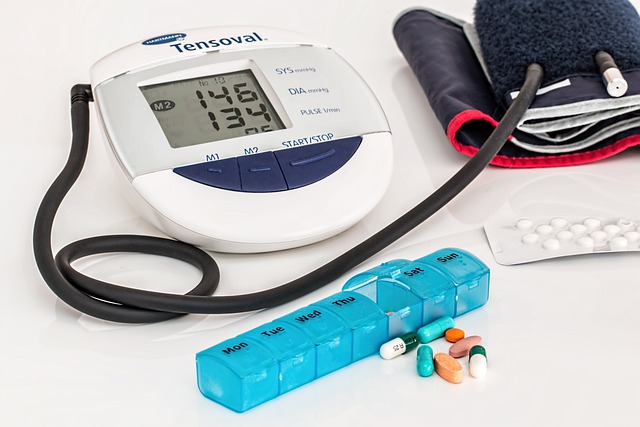Semaglutide medication is a revolutionary treatment for type 2 diabetes, mimicking natural hormones to lower blood sugar levels, support weight loss, and decrease complications. Key benefits include its dual action on insulin and glucagon secretion, sustained effects through weekly injections, improved glycemic control with fewer weight-related side effects, and potential long-term sustainability. Lifestyle modifications, including diet, exercise, hydration, and sleep, enhance treatment effectiveness. Regular blood sugar monitoring and open communication with healthcare providers are crucial for managing symptoms and adjustments. Semaglutide offers a promising solution for those who haven't responded well to other treatments, improving quality of life and reducing diabetes-related risks.
“Uncovering Effective Diabetes Management: The Role of Semaglutide Medication. Type 2 diabetes, a complex metabolic condition, can be effectively managed through various strategies. This article delves into the promising treatment option, Semaglutide, exploring its mechanism, benefits, and comprehensive approach to blood sugar control. From understanding the root causes to implementing lifestyle changes, we’ll guide you through every aspect of Semaglutide therapy. Discover how this medication, combined with patient success stories, offers a sustainable path towards improved diabetes management.”
Understanding Type 2 Diabetes: Causes and Risk Factors

Type 2 diabetes is a chronic condition that affects how your body processes blood sugar (glucose). Unlike type 1 diabetes, which is usually diagnosed in children and young adults and involves the absence of insulin production, type 2 diabetes often develops later in life. It’s characterized by insulin resistance, where cells don’t respond effectively to insulin, leading to elevated blood sugar levels. Insulin is a hormone that helps move glucose from food into your body’s cells for energy.
Several factors contribute to the development of type 2 diabetes. The primary risk factors include obesity, physical inactivity, family history, and age. Certain medical conditions like polycystic ovary syndrome (PCOS) and high blood pressure can also increase the likelihood. One notable medication that has shown promise in managing type 2 diabetes is semaglutide. It mimics a natural hormone to lower blood sugar levels, aid in weight loss, and reduce the risk of diabetes-related complications.
Semaglutide Medication: What is it and How Does it Work?

Semaglutide medication is a groundbreaking treatment option for type 2 diabetes, offering significant benefits in blood sugar control. It belongs to a class of drugs known as glucagon-like peptide-1 (GLP-1) receptor agonists. This medication mimics a natural hormone produced by the body, which stimulates insulin production and suppresses glucagon secretion in a glucose-dependent manner. By doing so, semaglutide helps lower blood sugar levels while also increasing feelings of fullness, leading to potential weight loss.
The medication is typically administered via subcutaneous injection once weekly, providing sustained effects. Its mechanism of action not only enhances insulin release but also slows the rate at which the stomach empties its contents, contributing to improved glucose control and reduced hunger pangs. Clinical studies have shown that semaglutide can lead to substantial reductions in HbA1c (a measure of long-term blood sugar control) and help patients achieve their glycemic targets with minimal side effects.
Benefits of Semaglutide in Managing Blood Sugar Levels

Semaglutide, a medication that mimics a natural hormone in your body, has shown remarkable benefits in managing blood sugar levels for people with type 2 diabetes. It works by slowing down the rate at which your stomach empties food, leading to reduced glucose absorption and subsequent spikes in blood sugar. This effect is particularly beneficial in improving insulin sensitivity and reducing hunger, both crucial aspects of controlling type 2 diabetes.
Clinical studies have demonstrated that semaglutide can help individuals achieve better glycemic control, often with fewer weight-related side effects compared to other medications. Its consistent performance has made it a game-changer for many patients, offering a more sustainable and effective approach to managing their condition in the long term.
Administering Semaglutide: Injection Methods and Dosage

Semaglutide, a medication known for its efficacy in managing type 2 diabetes, is typically administered through injections. The injection methods vary based on patient preference and healthcare provider’s recommendation, offering both pre-filled pens and vials with syringes. For convenience, many patients opt for the autoinjector pens, which provide precise doses and simplify the administration process.
Dosage plays a crucial role in the effectiveness of semaglutide treatment. The starting dose is usually low, around 0.25 mg once weekly, and can be gradually increased by healthcare professionals based on individual patient response. It’s essential to follow the prescribed schedule diligently as missed doses or inconsistent timing may impact blood sugar control. Regular monitoring of blood glucose levels is encouraged to ensure optimal dosing adjustments for better diabetes management.
Potential Side Effects and Management Strategies

Type 2 diabetes treatments, like semaglutide medication, can be effective in managing blood sugar levels but, like any medication, they come with potential side effects. Common ones include nausea, vomiting, diarrhea, and stomach pain, which are usually mild and temporary as your body adjusts. More serious but rare complications could include pancreatitis, kidney problems, or thyroid issues. To manage these side effects, it’s important to stay hydrated, maintain a balanced diet, and consult with your healthcare provider about any persistent or severe symptoms. They may adjust the dosage or suggest alternative treatments if needed.
Regular monitoring of blood sugar levels is crucial for managing diabetes effectively. Your doctor might recommend frequent testing to ensure that the semaglutide medication is working as intended. Additionally, keeping an eye on other health markers like blood pressure and cholesterol levels is essential for overall well-being. By adhering to a structured treatment plan, regularly communicating with healthcare providers, and making lifestyle adjustments, individuals with type 2 diabetes can successfully manage their condition while minimizing potential side effects.
Lifestyle Modifications to Complement Semaglutide Therapy

For individuals receiving semaglutide medication, lifestyle modifications can significantly enhance the effectiveness of treatment for type 2 diabetes. Adopting a balanced diet is crucial, focusing on whole grains, lean proteins, and healthy fats while reducing sugar intake. Regular physical activity is another key component; even moderate-intensity exercises like walking or swimming, performed consistently, can lower blood sugar levels and improve overall health.
Incorporating these lifestyle changes alongside semaglutide therapy allows for better blood sugar control. A supportive network of family and healthcare professionals can encourage adherence to dietary and exercise plans, making the journey towards diabetes management more manageable. Additionally, staying hydrated and prioritizing adequate sleep are simple yet powerful tools to complement semaglutide medication in stabilizing blood sugar levels.
Monitoring and Tracking Blood Sugar with Semaglutide

Semaglutide, a groundbreaking medication, offers a powerful tool in the management of type 2 diabetes. One of its key advantages lies in its ability to aid patients in monitoring and tracking their blood sugar levels effectively. This injectable drug works by mimicking the effects of a natural hormone, GLP-1, which stimulates insulin production and suppresses glucagon secretion, leading to improved glucose control.
With semaglutide, individuals with diabetes can gain better insights into their body’s response to food and physical activity. Regular monitoring allows for data-driven decisions about diet, exercise, and medication dosing. This continuous tracking enables patients to quickly identify patterns, make adjustments, and maintain stable blood sugar levels throughout the day. As a result, semaglutide becomes an invaluable asset in empowering individuals with type 2 diabetes to take charge of their health.
Long-term Use and Sustainability of Semaglutide Treatment

The long-term sustainability of semaglutide treatment for type 2 diabetes is a significant consideration, especially given the chronic nature of the condition. Studies have shown that patients who initiate semaglutide medication often experience sustained improvements in glycemic control over extended periods. This longevity in effect is a result of semaglutide’s unique mode of action, which involves regulating hormones and appetite, leading to consistent blood sugar management.
The ability to maintain these results without significant fluctuations or the need for additional interventions is a game-changer for patients’ quality of life. Long-term adherence to semaglutide treatment has been linked to reduced risks of diabetes-related complications, highlighting its potential as a sustainable solution within comprehensive diabetes management strategies.
Patient Success Stories: Real-life Experiences with Semaglutide

Many patients living with type 2 diabetes have found success and improved quality of life through the use of semaglutide medication. Real-life stories highlight the positive impact this injectable drug can have on blood sugar control and overall health. One patient, initially struggling with traditional treatments, shared their journey of reduced insulin needs and weight loss after incorporating semaglutide into their routine. They attribute their improved glycemic levels and increased energy to the medication’s ability to stimulate insulin production and suppress glucagon secretion.
These success stories are not isolated cases; numerous patients have reported similar benefits. Clinical trials have shown that semaglutide can lead to significant reductions in HbA1c levels, often making it a game-changer for those who haven’t seen the desired results from other treatments. Many patients appreciate the convenience of once-weekly injections and the potential for weight management, which is a common challenge in diabetes care.
